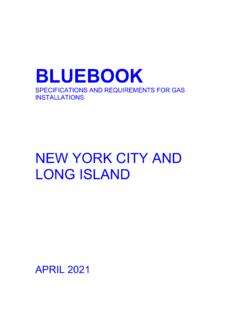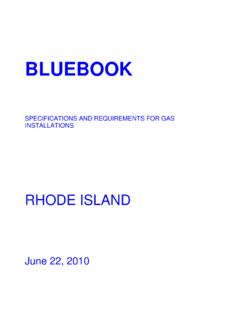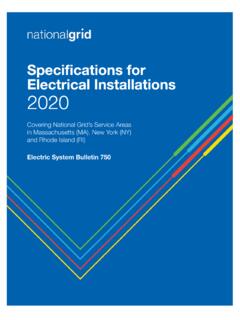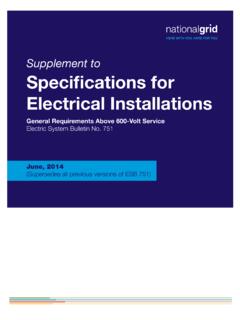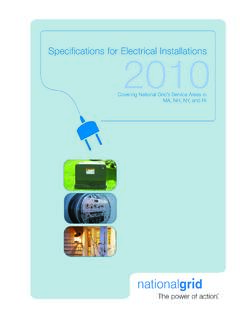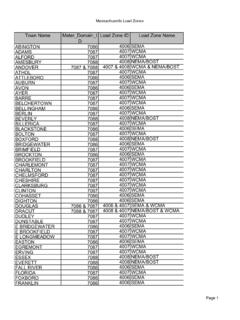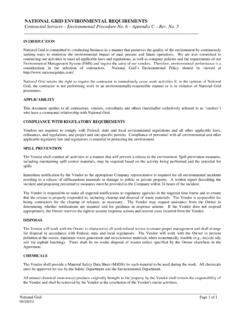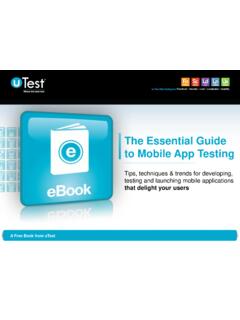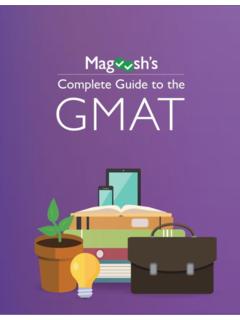Transcription of Climate Change, Renewables and Advancing the …
1 By Dean SeaversThe democratization of EnergyClimate Change, Renewables andAdvancing the American DreamJanuary 2017 Table of ContentsAn Efficiency Game ChangerSaving energy Along the Poles and Wires42 The Great TransitionMoving to a Decarbonized energy Infrastructure46 Clean energy Economic DevelopmentTriple Win of Lower Bills, Less Carbon, More Jobs64 About National Grid66 About the AuthorThe Transition BlueprintDesigning the Future of energy in the Northeast8 The New BuffaloA Case Study in energy Innovation14No One Left in the DarkA Solar Solution for Every Community18 Customer EmpowermentSmart Grid Programs in Worcester and Beyond36 The Future of Storm ResiliencyBuilding a Community Microgrid in New York State s North Country26 Flipping the SwitchBuilding a New energy Delivery Model, Democratizing energy .
2 And Advancing the American Dream458 Investing for ImpactEnergy-Driven Economic Developmentin Upstate New YorkGreen ConnectionsElectric Transmission and the Clean energy Future52 The Most Important Clean energy TechnologyHow Battery Storage Empowers energy Customers22 Working at the Pace of InnovationHarnessing New Clean energy Technologies to Benefit Customers Today and Tomorrow323672efficiency and productivity easier for all customers. (Today, 57 percent of our energy in the is wasted through heat loss, leaks, and inefficiencies.) We have seen a small number of smart grid installations scattered across the with technologies like wireless meters and web-based thermostats. In this ebook , you ll read about the smart grid pilots we have in the works, each with enormous potential for long-term energy savings and carbon , we must turn the grids into innovation playgrounds.
3 The legacy of our electricity and gas networks is that utilities were incentivized to become generally reactive and risk-averse to innovation. That must stop. We need to open our networks to high-tech partners focused on efficiency, energy storage, and distributed generation such as solar, wind, and biogas. Embracing our technology partners will propel the type of market-based advances that lifted the telecommunications and personal computing industries decades ago. Last, yet most important, we must change how we regulate and finance the industry. competitiveness, and increasing unemployment. That means more community needs chasing fewer and fewer community revenue sources. This concept of affordability combined with easy accessibility came to life in the in the 1930s and 1940s with FDR s Rural Electrification program and the Tennessee Valley Authority Act, among other policy efforts.
4 The democratization of energy proved fundamental to the economy and, by extension, the American do we transition to a decarbonized energy network by 2050 while growing local economies and ensuring our families long-term economic and environmental health? How do we do this while building a solution that engages everyone with a stake in our energy future? The remedy must start with our utility companies and our , we must put customers in charge. Consumers will make the right choices if they have the right tools and information. More web-based, big-data solutions will be transformational. Increasing the use of such smart technology will make choosing energy Many Americans who follow Climate change the great challenge of our time have rallied around a target year of 2050 for a decarbonized energy infrastructure in the As the leader of one of the nation s largest electricity and natural gas utilities, you can count me in.
5 Getting the transition right, of course, will be no small feat. No one knows this better than I. My first few years in the energy sector have made it clear that, while we ve built extraordinary networks over the last century, it s no longer business as usual. We need to accelerate the pace of change. Now. I believe we can get from our current mix of renewable and hydro power which makes up a small percentage of the energy consumed in New York and New England to a decarbonized energy network. But it will take the entire energy supply chain. System operators, generators, distributors, and customers as well as policy makers, technology companies, and Climate change activists will all need to collaborate at a level our nation has never seen National Grid, this desire for a decarbonized energy network isn t wishful thinking.
6 It s been our motivation for years. We serve the energy needs of 20 million people across New York, Massachusetts, and Rhode Island, so we know that as we build a solution to navigate this transition over the next several decades and beyond, our touchstone should always be customers, large and small, commercial and residential. Above all, energy must be affordable. Right now, electricity and gas customers are being whipsawed by monthly bill volatility in a number of regions. For instance, after years of low-cost electricity, New England saw prices surge in 2013 due to the interdependency between natural gas and electricity prices. Over the last three years, natural gas constraints cost electricity customers in the region an extra $7 Upstate New York, from cities such as Buffalo, Syracuse, and Albany, to small communities like Fredonia, Watertown, and Saratoga Springs, one in eight of our customers are more than 60 days behind on their electricity , the prerequisite of our transition solution must be affordability.
7 If not, we will strand working middle-class families and capital-challenged communities. This, in turn, will risk crippling local economies in a downward spiral of high energy costs, decreasing investment and business Flipping the SwitchBuilding a New EnergyDelivery Model, DemocratizingEnergy, and Advancing theAmerican DreamFlipping the Switch54 The energy industry must become a sector of innovators. Our fragmented industry in the 1,100 electric distribution companies plus 1,600 local natural gas delivery companies answers to an array of state and local regulators. While that regulatory relationship encourages a form of accountability, it hasn t traditionally prioritized aggressive investments in innovation and infrastructure.
8 But there are signs of change. In New York, for example, the Public Service Commission (PSC) put energy innovators on notice with its 68-page call-to-action, Reforming the energy Vision. They get it right, calling for a transformation of the regulator-utility-customer relationship. Instead of a narrow focus on just next month s bill, they ve widened the aperture to include solving for greater capital investing, increased energy efficiency programming, and facilitating connections to maturing renewable the PSC s most significant paradigm-busting idea is redefining utilities as a kind of smartphone for energy distribution, with energy generators, service providers, and technology partners delivering a range of energy solution apps.
9 At National Grid, we re aligning ourselves with this vision through what we call Connect21, and our New energy Solutions division: a team dedicated to driving our plan for the energy company of the future. That includes neighborhood solar, microgrids, smart grids, offshore wind energy , green transmission, and many other opportunities that advance our electricity and natural gas networks so that our 21st century digital economy is sitting atop a truly 21st century energy infrastructure. And while technology is crucial, there s another side of the story that no one is talking about: Who s going to drive this decarbonized innovation? We need to re-examine the way we lead where traditional utilities represent the classic top-down corporate model, the leaders creating the future of energy must model a raft of new behaviors, from becoming more transparent and collaborative with our customers, partners, and other stakeholders, to delegating decision-making to more employees, thereby bringing critical choices closer to customers.
10 That s especially important in light of the workforce crisis our industry is facing. More than half of energy employees are nearing retirement age, and that number increases every day. We need to find ways to transfer the tremendous knowledge of these workers to a new cohort of millenials and gen-xers, while building a culture of engagement, productivity, and customer chapters that follow tell that story and more: neighborhood solar for working families in Buffalo s Fruit Belt neighborhood; the Newtown Creek direct-to-grid biogas project; green transmission for large scale Renewables across New York and New England. These initiatives signal the transition to a decarbonized energy network. At the same time, they reinforce our fundamental approach to energy in the we find ways to ensure our communities long-term economic and environmental health.
